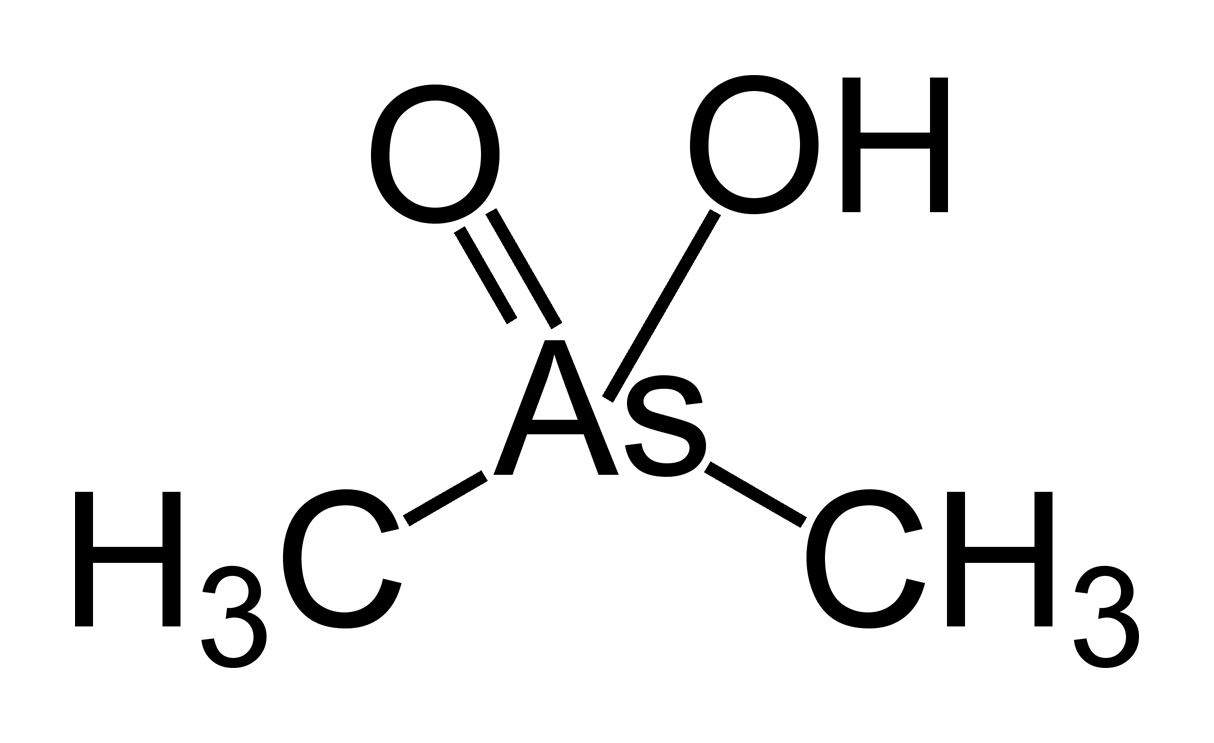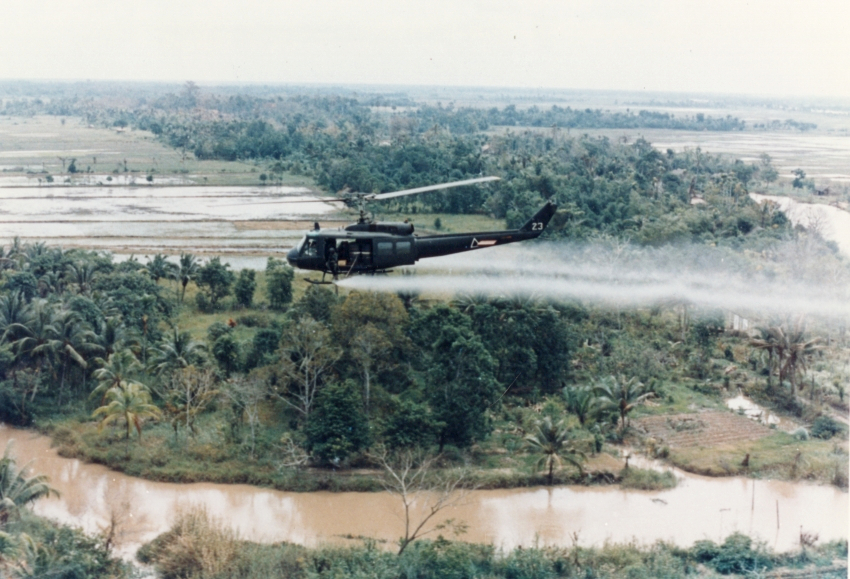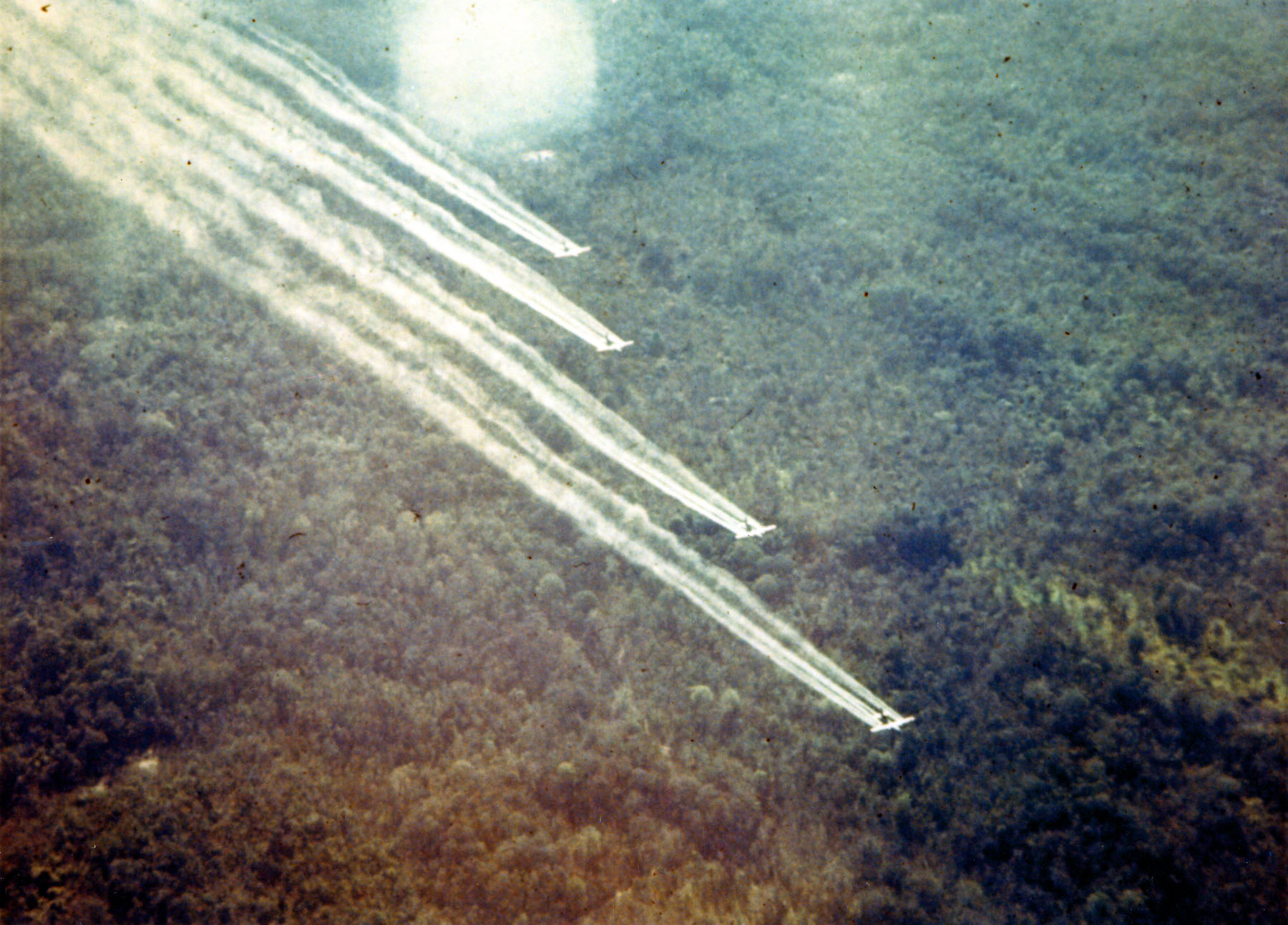|
Agent Blue
Agent Blue is one of the " rainbow herbicides" that is known for its use by the United States during the Vietnam War. It contained a mixture of dimethylarsinic acid (also known as cacodylic acid) and its related salt, sodium cacodylate, and water. Largely inspired by the British use of herbicides and defoliants during the Malayan Emergency, killing rice was a military strategy from the very start of US military involvement in Vietnam. At first, US soldiers attempted to blow up rice paddies and rice stocks, using mortars and hand grenades. But grains of rice were far more durable than they understood, and were not easily destroyed. Every grain that survived was a seed to be collected and planted again. A 1967 report to the International War Crimes Tribunal (founded by Bertrand Russell) stated that "The soldiers discovered that rice is one of the most maddeningly difficult substances to destroy; using thermite metal grenades it is almost impossible to make it burn and, even if on ... [...More Info...] [...Related Items...] OR: [Wikipedia] [Google] [Baidu] |
Thermite
Thermite () is a pyrotechnic composition of metal powder and metal oxide. When ignited by heat or chemical reaction, thermite undergoes an exothermic reduction-oxidation (redox) reaction. Most varieties are not explosive, but can create brief bursts of heat and high temperature in a small area. Its form of action is similar to that of other fuel-oxidizer mixtures, such as black powder. Thermites have diverse compositions. Fuels include aluminum, magnesium, titanium, zinc, silicon, and boron. Aluminum is common because of its high boiling point and low cost. Oxidizers include bismuth(III) oxide, boron(III) oxide, silicon(IV) oxide, chromium(III) oxide, manganese(IV) oxide, iron(III) oxide, iron(II,III) oxide, copper(II) oxide, and lead(II,IV) oxide. The reaction, also called the Goldschmidt process, is used for thermite welding, often used to join railway tracks. Thermites have also been used in metal refining, disabling munitions, and in incendiary weapons. Some thermite-like ... [...More Info...] [...Related Items...] OR: [Wikipedia] [Google] [Baidu] |
Arsenical Herbicides
Arsenicals are chemical compounds that contain arsenic. In a military context, the term arsenical refer to toxic arsenic compounds that are used as chemical warfare agents. This include blister agents, blood agents and vomiting agents. Examples Blister agents *Ethyldichloroarsine *Lewisite *Methyldichloroarsine *Phenyldichloroarsine Blood agents *Arsine Vomiting agents *Adamsite *Diphenylchlorarsine *Diphenylcyanoarsine *Phenyldichloroarsine Phenyldichloroarsine, also known by its wartime name phenyl Dick and its NATO abbreviation PD, is an organic arsenical vesicant and vomiting agent developed by Germany and France for use as a chemical warfare agent during World War I. The agent i ... References Arsenic compounds Chemical weapons Poisons {{Chem-stub ... [...More Info...] [...Related Items...] OR: [Wikipedia] [Google] [Baidu] |
Cotton Plant
''Gossypium'' () is a genus of flowering plants in the tribe Gossypieae of the mallow family, Malvaceae, from which cotton is harvested. It is native to tropical and subtropical regions of the Old and New Worlds. There are about 50 ''Gossypium'' species, making it the largest genus in the tribe Gossypieae, and new species continue to be discovered. The name of the genus is derived from the Arabic word ''goz'', which refers to a soft substance. Cotton is the primary natural fibre used by humans today, amounting to about 80% of world natural fibre production. Where cotton is cultivated, it is a major oilseed crop and a main protein source for animal feed. Cotton is thus of great importance for agriculture, industry and trade, especially for tropical and subtropical countries in Africa, South America and Asia. Consequently, the genus ''Gossypium'' has long attracted the attention of scientists. The origin of the genus ''Gossypium'' is dated to around 5–10 million years ... [...More Info...] [...Related Items...] OR: [Wikipedia] [Google] [Baidu] |
Cotton
Cotton is a soft, fluffy staple fiber that grows in a boll, or protective case, around the seeds of the cotton plants of the genus ''Gossypium'' in the mallow family Malvaceae. The fiber is almost pure cellulose, and can contain minor percentages of waxes, fats, pectins, and water. Under natural conditions, the cotton bolls will increase the dispersal of the seeds. The plant is a shrub native to tropical and subtropical regions around the world, including the Americas, Africa, Egypt and India. The greatest diversity of wild cotton species is found in Mexico, followed by Australia and Africa. Cotton was independently domesticated in the Old and New Worlds. The fiber is most often spun into yarn or thread and used to make a soft, breathable, and durable textile. The use of cotton for fabric is known to date to prehistoric times; fragments of cotton fabric dated to the fifth millennium BC have been found in the Indus Valley civilization, as well as fabric remnants dated back ... [...More Info...] [...Related Items...] OR: [Wikipedia] [Google] [Baidu] |
Weed Control
Weed control is a type of pest control, which attempts to stop or reduce growth of weeds, especially noxious weeds, with the aim of reducing their competition with desired flora and fauna including domesticated plants and livestock, and in natural settings preventing non native species competing with native species. Weed control is important in agriculture. Methods include hand cultivation with hoes, powered cultivation with cultivators, smothering with mulch, lethal wilting with high heat, burning, and chemical control with herbicides (weed killers). Need for control Weeds compete with productive crops or pasture, they can be poisonous, distasteful, produce burrs, thorns or otherwise interfere with the use and management of desirable plants by contaminating harvests or interfering with livestock. Weeds compete with crops for space, nutrients, water and light. Smaller, slower growing seedlings are more susceptible than those that are larger and more vigorous. Onions are one ... [...More Info...] [...Related Items...] OR: [Wikipedia] [Google] [Baidu] |
Ansul Chemical Company
Ansul is a corporation headquartered in Marinette, Wisconsin that manufactures fire suppression systems, extinguishers, and offers fire training. Ansul's initial activities included production of cattle feed, refrigerants and selected specialty chemicals. The name Ansul comes from ANhydrous SULfur dioxide ( SO2), which was sold to die works and fruit preservers, and later as a refrigerant.ANSUL: Who We Are Production of fire suppression chemicals began in 1934. Virginia Chemicals, Inc. (now part of ) acquired the Refrigeration and Air Conditioning Products Division of The Ansul Company in 1967, and by 1983 Ansul had discontinued all other production at the facility in ... [...More Info...] [...Related Items...] OR: [Wikipedia] [Google] [Baidu] |
Agent Orange
Agent Orange is a chemical herbicide and defoliant, one of the "tactical use" Rainbow Herbicides. It was used by the U.S. military as part of its herbicidal warfare program, Operation Ranch Hand, during the Vietnam War from 1961 to 1971. It is a mixture of equal parts of two herbicides, 2,4,5-T and 2,4-D. In addition to its damaging environmental effects, traces of dioxin (mainly TCDD, the most toxic of its type) found in the mixture have caused major health problems for many individuals who were exposed, and their offspring. Agent Orange was produced in the United States from the late 1940s and was used in industrial agriculture and was also sprayed along railroads and power lines to control undergrowth in forests. During the Vietnam War, the U.S. military procured over 20 million gallons consisting of a fifty-fifty mixture of 2,4-D and dioxin-contaminated 2,4,5-T. Nine chemical companies produced it: Dow Chemical Company, Monsanto Company, Diamond Shamrock Corporation, ... [...More Info...] [...Related Items...] OR: [Wikipedia] [Google] [Baidu] |
Viet Cong
, , war = the Vietnam War , image = FNL Flag.svg , caption = The flag of the Viet Cong, adopted in 1960, is a variation on the flag of North Vietnam. Sometimes the lower stripe was green. , active = 1954–1959 ''(as southern Viet Minh cadres)'' , ideology = , position = Far-left , leaders = Liberation Army: Central Office: Liberation Front:Burchett, Wilfred (1963):Liberation Front: Formation of the NLF, ''The Furtive War'', International Publishers, New York. Governance: , merged_into = Vietnamese Fatherland Front , clans = , headquarters = , area = Indochina, with a focus on South Vietnam , predecessor = Viet Minh , successor = Vietnam Fatherland Front , allies = , opponents = , battles = See full list The Viet Cong, ; contraction of (Vietnamese communist) was an armed communist organization in South Vietnam, ... [...More Info...] [...Related Items...] OR: [Wikipedia] [Google] [Baidu] |
Laos
Laos (, ''Lāo'' )), officially the Lao People's Democratic Republic ( Lao: ສາທາລະນະລັດ ປະຊາທິປະໄຕ ປະຊາຊົນລາວ, French: République démocratique populaire lao), is a socialist state and the only landlocked country in Southeast Asia. At the heart of the Indochinese Peninsula, Laos is bordered by Myanmar and China to the northwest, Vietnam to the east, Cambodia to the southeast, and Thailand to the west and southwest. Its capital and largest city is Vientiane. Present-day Laos traces its historic and cultural identity to Lan Xang, which existed from the 14th century to the 18th century as one of the largest kingdoms in Southeast Asia. Because of its central geographical location in Southeast Asia, the kingdom became a hub for overland trade and became wealthy economically and culturally. After a period of internal conflict, Lan Xang broke into three separate kingdoms: Luang Phrabang, Vientiane and Champasak. In ... [...More Info...] [...Related Items...] OR: [Wikipedia] [Google] [Baidu] |
Operation Ranch Hand
Operation Ranch Hand was a U.S. military operation during the Vietnam War, lasting from 1962 until 1971. Largely inspired by the British use of 2,4,5-T and 2,4-D ( Agent Orange) during the Malayan Emergency in the 1950s, it was part of the overall herbicidal warfare program during the war called "Operation Trail Dust". ''Ranch Hand'' involved spraying an estimated of defoliants and herbicides over rural areas of South Vietnam in an attempt to deprive the Viet Cong of food and vegetation cover. Areas of Laos and Cambodia were also sprayed to a lesser extent. Nearly 20,000 sorties were flown between 1961 and 1971. The "Ranch Handers" motto was "Only you can prevent a forest" – a take on the popular U.S. Forest Service poster slogan of Smokey Bear. During the ten years of spraying, over of forest and of crops were heavily damaged or destroyed. Around 20% of the forests of South Vietnam were sprayed at least once. The herbicides were sprayed by the U.S. Air Force flying C- ... [...More Info...] [...Related Items...] OR: [Wikipedia] [Google] [Baidu] |
Bertrand Russell
Bertrand Arthur William Russell, 3rd Earl Russell, (18 May 1872 – 2 February 1970) was a British mathematician, philosopher, logician, and public intellectual. He had a considerable influence on mathematics, logic, set theory, linguistics, artificial intelligence, cognitive science, computer science and various areas of analytic philosophy, especially philosophy of mathematics, philosophy of language, epistemology, and metaphysics.Stanford Encyclopedia of Philosophy"Bertrand Russell" 1 May 2003. He was one of the early 20th century's most prominent logicians, and a founder of analytic philosophy, along with his predecessor Gottlob Frege, his friend and colleague G. E. Moore and his student and protégé Ludwig Wittgenstein. Russell with Moore led the British "revolt against idealism". Together with his former teacher A. N. Whitehead, Russell wrote ''Principia Mathematica'', a milestone in the development of classical logic, and a major attempt to reduce the whole ... [...More Info...] [...Related Items...] OR: [Wikipedia] [Google] [Baidu] |








